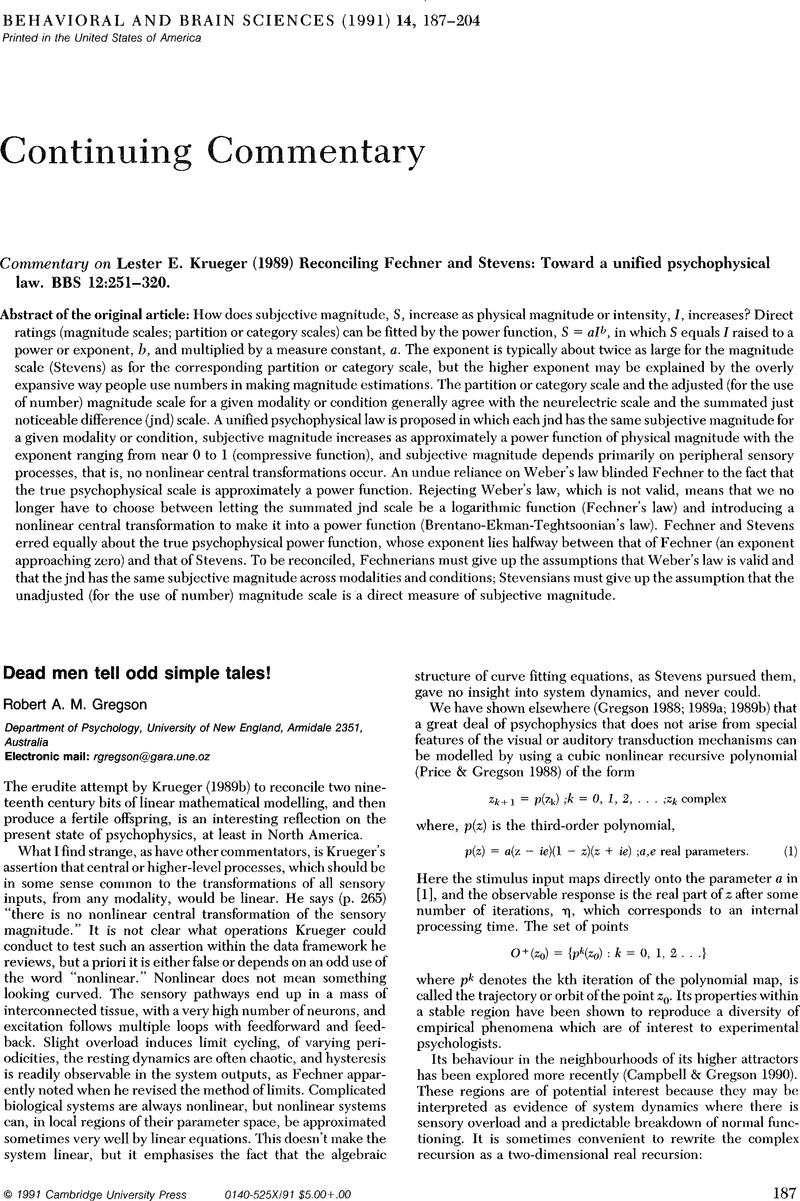Crossref Citations
This article has been cited by the following publications. This list is generated based on data provided by Crossref.
Coren, Stanley
1992.
Psychophysical scaling: Context and illusion.
Behavioral and Brain Sciences,
Vol. 15,
Issue. 3,
p.
563.
Teghtsoonian, Robert
1992.
Selecting one attribute for judgment is not an act of stupidity.
Behavioral and Brain Sciences,
Vol. 15,
Issue. 3,
p.
580.
Gregson, Robert A. M.
1992.
Walking in a psychophysical dustbowl creates a dustcloud.
Behavioral and Brain Sciences,
Vol. 15,
Issue. 3,
p.
568.
Niall, Keith K.
1992.
The evident object of inquiry.
Behavioral and Brain Sciences,
Vol. 15,
Issue. 3,
p.
578.
Borg, Gunnar
1992.
Psychophysical scaling: To describe relations or to uncover a law?.
Behavioral and Brain Sciences,
Vol. 15,
Issue. 3,
p.
561.
Gregory, Richard L.
1992.
Scales falling from the eyes?.
Behavioral and Brain Sciences,
Vol. 15,
Issue. 3,
p.
567.
Killeen, Peter R.
1992.
Psychophysics: Plus ça change ….
Behavioral and Brain Sciences,
Vol. 15,
Issue. 3,
p.
569.
Krueger, Lester E.
1992.
Will the real stimulus please step forward?.
Behavioral and Brain Sciences,
Vol. 15,
Issue. 3,
p.
570.
Bolanowski, Stanley J.
1992.
Lockhead's view of scaling: Something's fishy here.
Behavioral and Brain Sciences,
Vol. 15,
Issue. 3,
p.
560.
Masin, Sergio C.
1992.
Psychophysics and quantitative perceptual laws.
Behavioral and Brain Sciences,
Vol. 15,
Issue. 3,
p.
575.
Schneider, Bruce
1992.
Should the psychophysical model be rejected?.
Behavioral and Brain Sciences,
Vol. 15,
Issue. 3,
p.
579.
Bonnet, Claude
1992.
Psychophysical scaling within an information processing approach?.
Behavioral and Brain Sciences,
Vol. 15,
Issue. 3,
p.
560.
Warren, Richard M.
1992.
Relation of sensory scales to physical scales.
Behavioral and Brain Sciences,
Vol. 15,
Issue. 3,
p.
586.
Brysbaert, Marc
1992.
Accounting for an old inconsistency in the psychophysics of Plateau and Delboeuf.
Behavioral and Brain Sciences,
Vol. 15,
Issue. 3,
p.
562.
King, Donald L.
1992.
Context effects: Pervasiveness and analysis.
Behavioral and Brain Sciences,
Vol. 15,
Issue. 3,
p.
570.
Eisler, Hannes
1992.
Psychophysical invariance, perceptual invariance and the physicalistic trap.
Behavioral and Brain Sciences,
Vol. 15,
Issue. 3,
p.
566.
Dzhafarov, Ehtibar N.
1992.
Can brightness be related to luminance by a meaningful function?.
Behavioral and Brain Sciences,
Vol. 15,
Issue. 3,
p.
565.
Algom, Daniel
1992.
Perception, apperception and psychophysics.
Behavioral and Brain Sciences,
Vol. 15,
Issue. 3,
p.
558.
Monahan, John S.
1992.
Attributes or objects: A paradigm shift in psychophysics.
Behavioral and Brain Sciences,
Vol. 15,
Issue. 3,
p.
577.
Lockhead, Gregory R.
1992.
Constancy in a changing world.
Behavioral and Brain Sciences,
Vol. 15,
Issue. 3,
p.
587.



